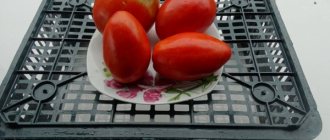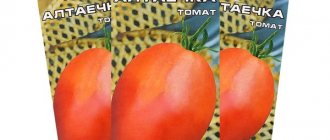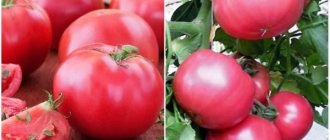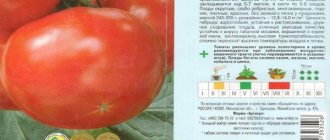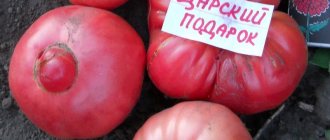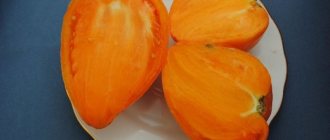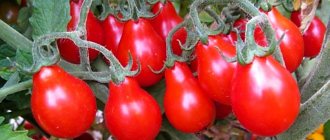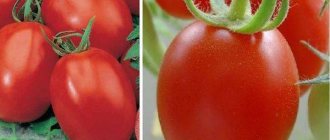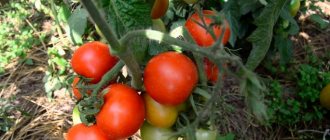Vasilina is one of the most popular tomato varieties in the West Siberian region. It is ideal for growing in these harsh places, it tolerates cold well without losing productivity, and its fruits taste no worse than heat-loving southern varieties.
| Height | Landing location | Ripening time | Fruit color | Fruit size | Origin | Fruit shape |
| Tall | Greenhouse, Open ground | Early ripening | Pink | Average | Variety | Flat-round |
Features of cultivation
The manufacturer recommends tomatoes for seedling cultivation.
Planting in the ground is possible only in the southern regions of the country if there is a favorable weather forecast. You can sow seeds as early as mid-March. They must first be treated with an antiseptic and saturated with nutrients. The seeds are buried in a container to a depth of 15-20 mm, covered with loose soil on top, and then placed in a warm place. The soil should be constantly moist, but not soggy.
After sprouts appear, containers with seedlings are moved to a place with good lighting and a stable temperature of 22°C. A week before moving the seedlings into the beds, they need to be hardened off. First, the plants are taken outside during the day, then this is done in the evening. The first fruits appear 75-80 days after planting the seeds.
Organic, mineral and complex fertilizers should be used as bait. They must be alternated so that there is no addictive effect. If you follow the rules of plant care, the first harvest will be in late spring in the southern regions and early summer in mid-latitudes.
How to grow Vasilina tomatoes?
Before planting, seedlings must be subjected to a hardening procedure: change the room temperature, maintain average watering, and protect from strong winds and direct sunlight. Seedlings should be planted in the ground to a depth of 2 cm, maintaining a distance between them. The soil is pre-moistened to an average level. When planting in greenhouses, you need to provide the plant with 16 hours of light per day.
After planting, the plant is looked after, watered promptly with warm water, and the soil is loosened, ensuring oxygen access to the roots. Tomatoes need to be regularly removed from weeds and fed 5-6 times per growing season. Fertilizing is carried out with complex mineral fertilizers, according to the instructions from the manufacturer.
When the height reaches 45-50 cm, the plant is tied up in the usual way. This is necessary in order to increase productivity, eliminate the risk of trunk breakage, and besides, a tied plant is easier to care for.
Bushes need to be pruned once every 10 days. This is necessary in order to control the growth of the bush and the number of its fruits. The more stepsons that are not removed, the fewer tomatoes on the bush. There is no need to remove the shoot to the base of the stem; you can leave 2 cm.
With proper care of the plant, you can get up to 15 kg of tomatoes from one square meter.
tomato Currency - description and characteristics of the variety
V. DADYKIN, scientist agronomist. Photo by the author.
To be honest, I personally didn’t believe it until I visited his (5.5 acres) plot in the Stroitel gardening partnership, on the outskirts of the town of Zhukovsky near Moscow, Ramensky district, Moscow region. I visited and photographed everything. I will reproduce our conversation that took place in the garden almost verbatim.
– Yuri Nikolaevich, let’s not only talk about your technology for growing heat-loving sissies, but also immediately clarify for readers that you grow tomatoes not in the open air, but under glass.
– Yes, although I have an old one, it is still a glass greenhouse, almost 47 m2. This is my “lifesaver”, and there is also a small tomato bed in the open ground (the latter, rather, for comparison, experiments and in case of hot summer). I don’t hide it: in the middle zone, the main condition for success when growing such a heat-loving crop as tomatoes is the construction of a greenhouse.
READ MORE: What flowers are there that look like daisies: list, names
For those who are too expensive for glass, the simplest one is suitable, with a frame made of wooden slats and plastic arches, which are covered with film or non-woven material in early spring. The difference between the temperatures inside such a greenhouse and outside is minimal: two to three degrees.
Therefore, in the spring and autumn, gardeners are forced to heat their greenhouses by any means available to them: some with a “potbelly stove” on diesel fuel, and some with an electric stove, heating element, or simply a constantly switched on electric light bulb.
Everyone has the same task: as early as possible, without wasting a single precious spring day, plant tomato seedlings in a greenhouse so that they have time to produce their potential harvest. After all, any, even the most productive varieties of heat-loving crops, as a rule, develop slowly in cool spring and June weather.
By the beginning of August, when many hobbyists are just beginning to bear fruit, they are destroyed by cold and late blight. Tomatoes, in order to have time to fully “give up” the harvest, need not one warm month (with nights at least 15-18 degrees), but four or five. That’s why I plant seedlings in my greenhouse in mid-April.
It is also important that I try to rationally use every meter of space in the greenhouse: in the free rows, between the tomato bushes, I place pots and other containers in which tomatoes also grow. At the end of May, or even at the beginning of June, when the nights become warm, I plant them in open ground.
– What else, besides the greenhouse and early planting dates, determines success?
– Please note: at high (more than 35 o C) and low (12-14 o C) temperatures in combination with high air humidity, tomato flowers are not pollinated and the ovary falls off. Therefore, during the day in July, it is necessary to either regularly ventilate closed greenhouses and greenhouses, or open them completely. I have provided through ventilation for this purpose (doors on two opposite sides and a window on top). In the spring, as well as in July, August, and even more so in September-October, the greenhouse doors should be tightly closed and all cracks sealed.
– Do fertilizers affect the yield and which ones do you use?
– Without effective fertilizers there will be no good harvest. What should it be formed from?
Each fruit plant “takes out” from the soil a total of one and a half dozen macro- and microelements every season. Therefore, they must be returned there in the fall or spring. But, however, with all the “gluttony,” the root system of tomatoes, especially young plants, is unable to effectively absorb nutrition from the soil, especially on cool nights.
For the second season I have been using humus from horse manure with vermicompost “Gardener’s Dream”. It contains a lot of phosphorus and potassium in organic form available to plants, which, as I said, is necessary for tomatoes. I use this organic matter at the stage of growing seedlings, adding 2 kg of it to each bucket of soil mixture.
In addition, when planting plants in a greenhouse, I again add 100-200 g of vermicompost to each hole. The result is similar: the development of tomatoes is noticeably accelerated. The harvest ripens two to three weeks earlier than usual.
– As far as I understand, you, as an amateur, have been growing tomatoes in one place for many years, although this is contrary to generally accepted recommendations: it leads to the accumulation of pathogens in the soil. Scientists recommend returning tomatoes to their original area only after four to five years and planting them only after predecessors such as cucumbers, cabbage, onions, legumes and green crops.
READ MORE: April cucumber: characteristics and description of the variety, cultivation with photos
– Theoretically this is true, but in practice it is impossible to implement such recommendations in a densely planted small area.
I see for myself: when cultivating tomatoes in one place for many years in a row, every year more and more different infections accumulate in the soil, and above all late blight pathogens. What should I do? Every two years we have to do labor-intensive work: completely replace the top ten-centimeter layer of soil in the greenhouse. And this means forced shoveling of tons of earth.
I recently learned about an alternative soil replacement - the FAS sulfur bomb, which can reliably disinfect the top layer of soil from almost any pathogen. I'll definitely try it out in the very near future.
– Now let’s talk about your famous varieties with supposedly incredible yields.
– Over the 25 years of my hobby, I have scrupulously tested and tested more than 500 different varieties and hybrids. Most of them were “rejected” due to low yield. The so-called “folk selection” varieties, which, alas, are almost unheard of now, turned out to be many times tastier and more productive.
Of course, not all of these varieties are truly good. In the first ten years of my research, I exchanged seeds and nutritional recipes with hundreds of distrustful and restless “tomato fans” like myself. In the end, I settled on tomatoes of undeniable merit (both in terms of yield and taste), which showed themselves not only in ideal conditions.
This is, first of all, the Yubileiny Ushakova variety I bred, and also Mechta, Bananchik, Mashenka. All of them are tall, on average up to one and a half meters, and early in maturity. And during a season without climate disasters, they produce an average of 8-10 kg of tomatoes per bush. The fruits are generally not large: Yubileiny Ushakova - 25 g each (about the size of a chicken yolk), Bananchik - 40-50, Mechta - up to 100 g.
Well, now about the most important thing: not only the potential yield of varieties is important, but also that it is realized even in not the most favorable conditions and when dangerous diseases are spreading. Here in the middle zone, the harvest of most varieties is destroyed in addition to the cold by late blight. What can resist it?
Using the example of my large collection of varieties, I undertake to assert: different varieties suffer to varying degrees from this destructive fungal disease. Thus, tomatoes of the Yubileiny Ushakov variety have not turned black for three years now. Of course, it is too early to draw final conclusions and it would be best to draw them together with scientists and variety testing specialists. I invite you to cooperation.
Description of the Danna tomato variety, its characteristics and cultivation
The Danna tomato will become the dream of many gardeners involved in vegetable growing in Northern and central Russia. The variety also shows high yields in regions where summers are quite cool. On the root, plants have time to grow early and ripen juicy, appetizing fruits, even with sudden temperature changes. In addition, when growing, tomatoes do not require much care, which is also an undoubted advantage.
Description of the variety
The Danna tomato is an early ripening vegetable crop of Russian selection. The variety was obtained in 1983 for cultivation in the Northern regions of Russia, Moldova and Ukraine.
Thanks to successful selection, tomato yields are always stable. Tomato harvesting occurs on days 110–117, after planting the seeds. The first brush of the inflorescence is formed above the 8th leaf of the plant, each subsequent one with an interval of 2 leaves.
- Dunn's tomato bush is not a standard type;
- plant height is 50–55 cm;
- medium leaf variety;
- the leaf is medium-sized, dark green;
- the inflorescence is complex, bearing more than 5 fruits.
The tomato is intended for growing in open ground. In order for the yield to come earlier, vegetables can also be grown in greenhouses and greenhouse structures.
Fruit characteristics
Dunn's universal tomato. Its fruits are suitable for preparing salads, hot dishes and various kinds of preparations for the winter. Thanks to their strong skin and small weight, tomatoes are also well used in whole-fruit canning.
Product characteristics of tomato:
- weight – 95–105 g;
- shape – flat-round;
- color – bright red;
- pulp – fleshy;
- taste qualities are excellent.
A distinctive feature of Dunn tomatoes is that they contain about 5.3% dry matter.
Advantages of the variety
Like all vegetable crops, the Danna variety is endowed with individual advantages. The strengths of the volume include:
- high yield, which ranges from 3 to 5 kg per bush;
- good transportation over long distances;
- excellent taste;
- cold resistance;
- resistance to late blight;
- ease of care.
According to experts, the variety has no significant shortcomings.
Important: Despite the fact that the Danna variety is resistant to late blight, for prevention it is still recommended to spray it with “Fitosporin” 3 times during the season
Tips for growing the variety
Those who grew Dunn's culture claim that to get a high yield, you should adhere to the following rules:
- To obtain full-fledged seedlings, it is necessary to sow the seeds quite densely.
- When 2 true leaves are formed on the seedlings, strong, well-developed plants are selected and picked.
- Seedlings are planted in open ground only after frost has passed.
- The area for tomatoes should be well lit and protected from northern winds.
- Planting pattern 40x60 cm.
- During growth, plants are fed with root and foliar complex fertilizers.
Reviews from gardeners indicate that tomatoes do not require pinching or support. For the development of the plant, timely watering, weeding and loosening of the tree trunk are carried out.
“Danna has been planting tomatoes for several years in a row. I liked this variety for its low bushes, on which the fruits were compactly collected. The yield was also encouraging. From each bush I collected about 3 kg of tomatoes. The tomatoes are tasty, beautiful in appearance, and very good for preparing canned whole fruits and salads.” N. G. Apt
“I planted different varieties of tomatoes in my dacha. One of the best tomatoes I can highlight is Danna. The plant is absolutely undemanding in care and resistant to sudden cold snaps. In addition, tomato annually shows good yield indicators” Dmitry Ascheulov
Description of the tomato variety Vasilina, its characteristics and cultivation
Tomatoes are a storehouse of useful vitamins and minerals. Tomato fruits are not only healthy, but also have good taste. Most gardeners in Russia allocate at least several beds for planting. Every year, breeders add to the number of varieties, breeding more stress-resistant and productive species. The Vasilina tomato is one of the popular productive varieties, included in the state register for the West Siberian region.
General information about the plant
The tomato variety Vasilina is recommended by the originator for growing in open ground and film shelters. It is necessary to choose a place for planting based on the climatic features of the zoning. Characteristics of tomato and external features of the plant:
- An early ripening variety, the berries are harvested after 95–100 days.
- High yield, up to 495 hectares are obtained from one hectare of crops.
- Indeterminate.
- Tall.
- The height of the bush is up to 150 centimeters.
- Leaves are medium sized.
- Green leaf color.
- Medium branched.
- Semi-spreading.
- Inflorescences of intermediate type.
- Dark spot near the stalk.
- Pedicel with articulation.
- Stable immunity to most nightshade diseases.
- Stress-resistant.
- Cold-resistant.
- Good keeping quality.
- Transportability of fruits.
Reviews of the early ripening tomato Vasilina indicate successful cultivation of the plant outside its homeland. Technical data and description of fruits:
- Light green color when immature.
- Raspberry color when ripe.
- The number of nests is from four pieces.
- Maximum weight 200 grams.
- Good taste.
- No sourness.
- Prone to cracking.
- Round shape.
- High density.
- Not watery.
IMPORTANT! The yield of marketable fruits is up to 93%.
Tomato belongs to the salad varieties. The fruits are suitable for fresh consumption, as an ingredient for salads and stuffing. The berries are used for preparing preparations, salted and pickled. The fruit is used for processing, making purees and juice.
Growing Tips
The plant is recommended for seedling planting. You can get healthy seedlings by following a number of rules:
- Plant to a depth of 1.5–2 centimeters.
- Preliminary moistening of the soil.
- Maintaining room temperature from 21 degrees.
- Timely moistening of the soil.
- Organization of 16-hour daylight hours.
- 10 days before planting, it is necessary to harden the sprouts.
The plant is unpretentious; the originator advises planting no more than four bushes on one square meter of land according to a 50x40 centimeter pattern.
For better yield, you should follow simple rules of agricultural technology: watering with warm water, loosening the soil, removing weeds, fertilizing up to 6 times per season, tying to a trellis and installing supports. When tying, synthetic materials should be used.
Description of the variety
This variety of tomatoes was bred in order to grow them under film. The variety is characterized by the following description:
- the plant is undersized, grows no more than 0.5 m in height;
- the first ripe fruits can be harvested within three months after the first shoots;
- the pulp of the fruit is tender, medium density and tasty;
- with proper cultivation, fruits can weigh up to 250 g, although they usually do not reach 200 g;
- from one bush you can collect up to 4 kg of fruit;
- the fact that it ripens very early makes it possible to grow it in the northern regions, you just need to provide the tomato with favorable conditions in the form of warm, sheltered beds;
- tolerates drought well, but bears fruit better if it is watered correctly and regularly;
- the variety is resistant to various diseases and is practically not subject to root rot;
- the fruits can be perfectly preserved and are suitable for juices or ketchup;
This variety of tomatoes, unlike the Your Honor tomato or the Shaggy Bumblebee tomato, is perfectly stored and can withstand transportation. This is what has made its cultivation a profitable business for many. And the characteristics and description on the packaging fully correspond to expectations.
We suggest you familiarize yourself with Which cement is best for paving slabs
Description of fruits
Many cold-resistant varieties are distinguished by the fact that they are not particularly productive. This is due to their size, since most tomatoes for the northern regions are short. They do not produce a large number of fruits. But Vasilina differs from these options in its high fruitfulness.
The fruits of the Vasilina variety are very sweet and soft, as evidenced by reviews from gardeners. Tomatoes become an excellent component of summer vegetable salads and snacks. But they can also be used for canning.
The skin of these tomatoes is quite soft, so they can crack when canned as a whole. Moreover, this makes them unsuitable for long-term storage. When transporting the Vasilina variety, special care should be taken, as the tomatoes may be damaged.
Tomatoes are great for salads, sauces and juices. They have almost completely no sourness. The average weight of the fruit is 200 g. The tomatoes are round and not watery, with a lot of sugars.
Growing conditions
How to grow sweet tomatoes? To make tomatoes sweet and meaty, it’s not enough to choose the right variety. The soil must have enough nutrients, and there are also other secrets:
- The most delicious are varietal tomatoes, not hybrid ones;
- to add sweetness, fertilizers are added, such as potassium or wood ash, which promote better fruit filling and improve taste;
- During fruiting, you should not apply nitrogen fertilizers, as they promote the growth of greenery;
- the amount of sunlight affects the sugar content; the more sunlight there is, the sweeter the tomatoes will be;
- The amount of watering should be limited during fruiting.
Anyone who grows vegetables in their garden can share a list of the sweetest varieties of tomatoes, a description of which is presented below.
What's ripening?
Sometimes the description of a large-fruited tomato variety is captivating. The manufacturer promises a combination of yield and taste. The reality is disappointing.
But the Keg is another matter. Gardeners are attracted to:
- fruit size (300–500 g);
- evenness (the first and subsequent berries are the same);
- color (orange-golden);
- skin (thin, cannot be felt when eating);
- the hand feels smooth to the touch;
- weak ribbing at the stalk;
- 3–4 seed chambers;
- the grains are small (do not interfere with eating);
- the taste is sweetish;
- the pulp is juicy;
- pronounced graininess.
Russian gardens have created a hybrid for delicious salads. But gardeners have made adjustments: they like the possibility of universal use of berries. The juices and pastes have a beautiful apricot hue. The sugar content allows you to avoid adding seasoning when canning.
Description of the tomato variety Eastern Star and its characteristicsRead
Tomato Sinichka - description and characteristics of the variety
Not everyone has country plots, and not everyone can boast of having a dacha. And those who have it are not always able to fully cultivate the area - age and illness deprive them of this opportunity. But experienced gardeners don’t want to sit at home with nothing to do, and they find something to do - grow flowers on windowsills and windows that delight the soul and the eye. But you can also grow edible plants - for example, small tomatoes, which can be cultivated in an ordinary apartment - on windows, balconies and loggias. One such plant is tomatoes. We will talk about a variety called Sinichka.
Characteristics of the variety
Tomatoes called Sinichka are suitable for growing both indoors and in suburban areas. In the first case, you can grow tomatoes all year round.
- It is an early ripening variety; the berries ripen in 85-95 days.
- Determinate type.
Such bushes will decorate any home, and if there are berries hanging on them, they will serve as an excellent decorative decoration for the apartment.
- The shape resembles a cherry.
- The berries are small, weighing no more than 20 grams each.
- The taste is sweet, honey.
- Ripe tomatoes have a bright yellow color.
- There is a dark spot around the stalk.
- The skin is thin, smooth, without serrations, dense.
- Ripe berries do not crack and smell strongly of tomatoes.
Recommendations to help raise a Titmouse
As a rule, these tomatoes are intended for growing at home. To cultivate this variety at home, you need to follow some rules:
- Choose the right container where the crop will be planted. Boxes with a height of 12 to 16 centimeters are best suited.
- In order for air to flow better to the root system, the bottom of the box should be lined with pieces of old slate or tiles; it is useful to add a little sand.
- In order for the plant to develop normally, it is best to buy specialized soil intended for tomatoes.
- The seeds are pre-treated with potassium permanganate - this will protect against fungus and help them germinate better.
- It is necessary to observe a certain temperature regime. - during the day from 20 degrees Celsius, at night - from 14-15 degrees.
- It is necessary to create an influx of fresh air by regularly ventilating the room.
- The variety needs a lot of light, so in the dark after sunset it is necessary to illuminate the tomatoes with fluorescent lamps or other sources.
- The first sprouts after planting the seeds appear in about a week; they are watered abundantly with warm water.
- After the formation of one or two leaves, the plant must be pruned, that is, planted in separate boxes.
- There is no point in forming bushes and tying them up, because the bushes are small and there is no danger of breaking under a large layer of crop.
- The plant requires pinching and removal of old leaves from the branches and stems.
- The plant should be watered twice or thrice a week. After each watering, the soil must be loosened, otherwise the earth will harden into a crust and air will not flow to the roots.
Landing at the site
It is better to plant on store-bought tomato soil. It is necessary to add fertilizers containing nitrogen. And when the first ovary appears, feed it with mineral fertilizer.
It is necessary to hill up, water and loosen the soil in accordance with generally accepted methods.
Diseases and pests
Tomatoes planted in the country can be attacked by numerous pests. To combat them, it is enough to spray the bushes with protective drugs. The Sinichka variety has high immunity, but it is still better to treat it with appropriate preparations to avoid infection with common diseases for nightshade crops.
Characteristics of the variety
Vasilina is the best option for those who live in places with cold and short summers. These tomatoes have characteristics that allow them to successfully survive even in extreme cold weather. At the same time, the ovaries are not lost at all, and the yield remains at a consistently high level.
Depending on the region in which the fruits of a given variety will be grown, you can choose the most suitable conditions. For places with cold summers, a greenhouse option is best, and for warm regions, open ground will be the optimal condition for growing tomatoes. The Vasilina variety is suitable for any occasion.
These tomatoes are considered indeterminate. They can grow to very large sizes, so the bushes must be pinched back. This will allow the formed berries to become larger.
Tall tomatoes require special care. They can break from the weight of the fruit or from the wind, so the bushes must be tied up. Moreover, do not forget that the plant requires mandatory formation. Removal of stepson branches is mandatory for the specified variety.
Video: Tomato Vasilina (vasilina)? Vasilina tomato review: how to plant Vasilina tomato seeds
Video: THE BEST VARIETY OF LOW GROWING TOMATOES!
The bushes turn out to be quite leafy and lush. This means that it will not be possible to plant a large number of plants per 1 m². The best option would be a planting scheme of 4 bushes per meter of fertilized soil. Fertilizers for this variety are very important. They allow you to get a fairly large harvest. With the right agricultural technology, you can collect up to 20 kg of tasty fruits from each square.
Fruit harvesting can begin within 95 days from the date of sowing the seeds for seedlings. Considering that the variety is early ripening, it is not afraid of some diseases. Moreover, the breeders tried their best and developed a really high-quality tomato that is resistant to most of the ailments characteristic of nightshades. However, if they are grown in greenhouse conditions, preventive measures against fungal diseases should be carried out.
Characteristics of the Beauty tomato and growing a hybrid variety
Tomato Beauty f1 got its name because of its beautiful appearance. During the period of full ripening, Beauty pleases its owners with bright crimson tomatoes. The shape and size of all fruits are almost the same. Tomatoes have elastic skin that is not prone to cracking. This makes them resistant to transportation and long-term storage. Fruit weight – 150-200 g.
What is a Beauty tomato?
The characteristics and description of the variety are as follows:
- The tomato ripens in 100-110 days.
- This is a hybrid variety that is resistant to weather conditions and various diseases.
- High yield and good taste are the main indicators of tomatoes.
- This variety can be grown in any region of our country.
- Tomatoes are planted in open ground in warm areas, and in cold areas - under a film cover. At temperatures below +16…+17ºС the plant dies.
How to grow tomatoes?
How to grow Beauty f1 tomatoes? The seeds are ready for planting by the end of March. They are planted in soil containing peat, sand and ash or purchased with a ready-made substrate. For planting, choose a shallow container. The seeds are planted in a row, maintaining a distance of 3-5 cm. Planting depth is 1 cm. To speed up the process of hatching, the soil is sprayed with water and covered with film. The film covering is not opened until the first shoots appear.
Picking is done after the formation of 2-3 true leaves. At this stage of development, the plant needs warmth and light. Seedlings should be protected from direct sunlight. Instead of watering, it is recommended to spray the soil with a spray bottle once a week.
An important activity is hardening off the seedlings, especially if they are preparing to plant them in open ground. 2 weeks before the intended transplantation, the seedlings are accustomed to outdoor conditions. To do this, they are taken out into the air every day, initially for a few minutes, gradually increasing the time.
Tomato belongs to the determinate species. The plant is not very tall, reaches a height of 80 cm. During the growth process, the stems form and moderately shoot. The trunk stops growing after the formation of 5-6 flower clusters. Since the root system of tomatoes is small, 1 or 2 stems are left during formation. This way the fruits will receive adequate nutrition and will not waste their taste.
To prevent the bushes from getting sick and feel comfortable, you need to plant them in one row at a distance of 50-60 cm from each other. The plant will be greatly supported by tying it to supports. The lower leaves in contact with the ground are removed to facilitate watering and prevent fungal infections.
The soil must be loosened periodically. This action improves the drainage properties of the soil
This must be done extremely carefully so as not to damage the roots. You need to be attentive to the appearance of weeds and remove them in a timely manner.
Weeds feed on fertilizers, which are needed for the development of tomatoes.
Next, we will consider the features of applying fertilizers for tomatoes. When the plant begins to bear fruit, the amount of nitrogen in fertilizers must be sharply reduced or removed. This chemical element promotes the growth of green mass, which is absolutely not necessary at the time of fruit filling.
When setting fruit, the plant needs the components of boron, manganese, iodine and potassium. They affect the meatiness of tomatoes and the high sugar content. You can prepare this dressing yourself. To do this, you need to mix wood ash, boric acid and iodine.
Reviews about the Krasotka variety are positive
People who have been growing tomatoes for many years are advised to pay special attention to the quality of the soil. They believe that the survival rate of tomatoes largely depends on it
In general, gardeners are satisfied with the Krasotka variety. They are especially pleased with the good sweet taste.
General information about the plant
The tomato variety Vasilina is recommended by the originator for growing in open ground and film shelters. It is necessary to choose a place for planting based on the climatic features of the zoning. Characteristics of tomato and external features of the plant:
- An early ripening variety, the berries are harvested after 95–100 days.
- High yield, up to 495 hectares are obtained from one hectare of crops.
- Indeterminate.
- Tall.
- The height of the bush is up to 150 centimeters.
- Leaves are medium sized.
- Green leaf color.
- Medium branched.
- Semi-spreading.
- Inflorescences of intermediate type.
- Dark spot near the stalk.
- Pedicel with articulation.
- Stable immunity to most nightshade diseases.
- Stress-resistant.
- Cold-resistant.
- Good keeping quality.
- Transportability of fruits.
Reviews of the early ripening tomato Vasilina indicate successful cultivation of the plant outside its homeland. Technical data and description of fruits:
- Light green color when immature.
- Raspberry color when ripe.
- The number of nests is from four pieces.
- Maximum weight 200 grams.
- Good taste.
- No sourness.
- Prone to cracking.
- Round shape.
- High density.
- Not watery.
IMPORTANT! The yield of marketable fruits is up to 93%.
Tomato belongs to the salad varieties. The fruits are suitable for fresh consumption, as an ingredient for salads and stuffing. The berries are used for preparing preparations, salted and pickled. The fruit is used for processing, making purees and juice.
Barrel - variety of tomato plant
Information on the admission of Tomato Barrel from the Register of the State Variety Commission of the Russian Federation
Application for admission No. 48220, registered 2007-09-17. The Tomato Barrel variety was included in the register of approved varieties in 2008. Approved for use in regions: All regions.
The originator of the Tomato Barrel variety is:
Other varieties of tomato plant
Question to the portal experts
If you haven't found the answer to a question, don't hesitate to ask an expert.
Register or Login so you don't have to enter your Name and Email every time
Thanks for the comment! It will be published after checking by a moderator!
No comments yet, be the first!
A portal for those who love their dacha
Your question has been sent for moderation. Don't worry, we quickly check your questions and your question will be answered within 1 day.
We have noticed that you are already registered on our website. We recommend that you log in to view the created question.
If you don't remember your password, you can recover it.
You were not registered until today, so we have registered you. Your password has been sent to your specified mailbox.
Please read this message, it will not take up much of your time!
Tomato Grotto - description and characteristics of the variety
The Deepening tomato variety has been successfully grown for two decades. It was first bred through selection in Russia in the early 90s of the 20th century. The current variety is good because it can be grown even in apartment conditions and is not demanding on the sowing area. The autochoir itself is short, reaching 30-40 cm in height, almost like a houseplant on a balcony, loggia, or window sill. But this does not mean that it cannot be grown in greenhouse conditions. This tomato does not take up much space or width, since the crown is not spreading and dense.
Characteristic
The leaves are ordinary, quite large, green with a glossy sheen, with an uneven folded surface. Inflorescences without branches, the first of which is formed above the 6th or 7th leaf. The tail is articulated and the sepals are long. Each bush can contain from 7 to 8 fruiting brushes.
The fruits are round and smooth. The color of still unripe tomatoes is green; there is a characteristic dark spot closer to the stalk; those that are already ripe have a pleasant, vibrant red color. The weight of one tomato can reach 50 grams, and those grown in greenhouse conditions can be slightly larger, 20-30 grams.
The yield is quite high, and is suitable for one square meter of plot. Ant. you cannot get about 5-7 kilograms of products; one bush gives 3 kilograms to the eye. In terms of taste, these tomatoes are sweet with a sour aftertaste. Due to the dense peel, the period of safe storage and transportation is long.
The article number of Grotto tomatoes is great for home canning and adding fresh to salads; on an industrial scale it is good for canning, drying, and the production of ketchups and sauces.
Growing up and setting sail
Growing a crop involves carrying out the following activities:
- In order to get a harvest as soon as possible, you need to prepare seedlings first. It is best to germinate seeds in turf soil mixed with leaves, compost and sand. To remove fungi and other pathogenic agents, the soil is disinfected with a one percent solution of potassium permanganate, as well as with boiling water. The seeds should not be planted very deep, at most one centimeter from the surface of the soil. Then they are covered with peat and watered. After a couple of leaves appear, the shoots are divided into separate plastic cups or pots.
- Seedlings aged one and a half months are planted in the spring, in March. Before planting in open ground, you need to harden the sprouts, periodically ventilating the insert with them. It is this season that natural sunlight contributes to the rapid growth process and the appearance of fruits in April-May.
- Stepsonning. A characteristic feature of “Grotto” is the halt in stem growth after the fruits appear. All energy is focused on their maturation. To enhance this process, you need to remove additional shoots. Then the tomatoes will become even larger and meatier.
- Tying. Short stature does not guarantee that the stem will not break and the fruits will not end up in the ground. Because of this, it must be tied to pegs or trellis in any case.
- Feeding. An indispensable stage of care. Watering should be done sparingly to avoid rotting of the roots.
- Chiselization of the soil is necessary for normal growth of roots and access of oxygen to them. There are no words during fasting, the stem must be hilled.
Diseases
Unfortunately, the “Grotto” genus, like most others, is not resistant to such diseases, i.e.:
- Late blight is a fungal infection of stems, leaves, and fruits.
- Septoria - manifests itself in the form of white spots on the top of the leaves, fungal in nature.
- Macrosporiasis is a fungus that constantly affects parts of the plant and is characterized by large brown spots.
- Black bacterial spot.
In other words, consumers evaluate the variety
Summer residents and tenants evaluate Grotto tomatoes in the final analysis. According to their reviews, the harvest is quite decent, fruit production lasts 3-4 months, and the taste is good. According to housewives, simultaneous ripening of fruits is very convenient for harvesting
It is important that caring for it is easy
Description and characteristics of the variety
Tomato Vasilina is an indeterminate plant. The growth of the bushes is not limited, they stretch up to one and a half meters, semi-spreading, with an average number of branches, heavily leafy. There is a spot on the stalk. The variety is early ripening, the first fruits reach maturity 95-100 days after sprouting. Tomatoes are soft, juicy, sugary, have a sweet taste with almost no sourness. They are medium in size and weigh 85-200 g. They can be used for canning, fresh consumption, and processing into juices.
Thanks to early ripening, tomato is resistant to a number of diseases, in particular late blight.
Disease prevention and pest protection
The Pink Honey variety is not resistant to diseases, so plants need proper and regular treatment. In case of excess heat and humidity, the development of brown rot - cladosporiosis - is likely. At the initial signs of fungal diseases, treating the plant with fungicides, for example, Ridomil, will help.
During the flowering period, it is recommended to treat the leaves with boron solution - 1 g of boron per 1 liter of water. Another option is treatment with a mixture prepared from 10 liters of water and 2 tablespoons of copper sulfate. It is recommended to spray the affected stems with a 1% solution of calcium chloride.
In the fight against insect pests, it is recommended to periodically spray the plant with a soap solution, which is used to irrigate even mature fruits.
Yeasts suppress the proliferation of pathogenic microorganisms and also promote plant growth and development. In 2.7 liters of settled water, dilute 100 g of yeast, 0.5 tbsp. sugar, cover with gauze and leave in a warm place, shaking from time to time. When the fermentation process is over, 1 glass of infusion is diluted in 10 liters of water and watered at the rate of 1 liter per bush.
A cloth soaked in vinegar can be an effective remedy against root pests. In order to protect the root system, apply fabric strips soaked in table vinegar. However, the effect of such treatment is short-lived, since the fabric requires constant renewal. Another good remedy against earthen insects is planting legumes on tomato beds.
- Gray rot. To prevent the occurrence of the disease, treat tomato plantings using any appropriate fungicide;
- Be sure to observe crop rotation;
- Conduct regular inspections of plantings for timely detection of diseases and pests.
Tomato Vasilina: variety description
The Vasilina tomato is known to many gardeners living in the West Siberian region. Here these tomatoes are in demand primarily because they can withstand many vagaries of the weather.
Characteristics of the variety
Vasilina is the best option for those who live in places with cold and short summers. These tomatoes have characteristics that allow them to successfully survive even in extreme cold weather. At the same time, the ovaries are not lost at all, and the yield remains at a consistently high level.
Depending on the region in which the fruits of a given variety will be grown, you can choose the most suitable conditions. For places with cold summers, a greenhouse option is best, and for warm regions, open ground will be the optimal condition for growing tomatoes. The Vasilina variety is suitable for any occasion.
These tomatoes are considered indeterminate. They can grow to very large sizes, so the bushes must be pinched back. This will allow the formed berries to become larger.
Tall tomatoes require special care. They can break from the weight of the fruit or from the wind, so the bushes must be tied up. Moreover, do not forget that the plant requires mandatory formation. Removal of stepson branches is mandatory for the specified variety.
The bushes turn out to be quite leafy and lush. This means that it will not be possible to plant a large number of plants per 1 m². The best option would be a planting scheme of 4 bushes per meter of fertilized soil. Fertilizers for this variety are very important. They allow you to get a fairly large harvest. With the right agricultural technology, you can collect up to 20 kg of tasty fruits from each square.
Fruit harvesting can begin within 95 days from the date of sowing the seeds for seedlings. Considering that the variety is early ripening, it is not afraid of some diseases. Moreover, the breeders tried their best and developed a really high-quality tomato that is resistant to most of the ailments characteristic of nightshades. However, if they are grown in greenhouse conditions, preventive measures against fungal diseases should be carried out.
Description of fruits
Many cold-resistant varieties are distinguished by the fact that they are not particularly productive. This is due to their size, since most tomatoes for the northern regions are short. They do not produce a large number of fruits. But Vasilina differs from these options in its high fruitfulness.
The fruits of the Vasilina variety are very sweet and soft, as evidenced by reviews from gardeners. Tomatoes become an excellent component of summer vegetable salads and snacks. But they can also be used for canning.
The skin of these tomatoes is quite soft, so they can crack when canned as a whole. Moreover, this makes them unsuitable for long-term storage
When transporting the Vasilina variety, special care should be taken, as the tomatoes may be damaged.
Tomatoes are great for salads, sauces and juices. They have almost completely no sourness. The average weight of the fruit is 200 g. The tomatoes are round and not watery, with a lot of sugars.
The favorite of farmers from Siberia is the Vasilina tomato: a detailed description of the variety and its characteristics
Vasilina is one of the most popular tomato varieties in the West Siberian region. It is ideal for growing in these harsh places, it tolerates cold well without losing productivity, and its fruits taste no worse than heat-loving southern varieties.
| Height | Landing location | Ripening time | Fruit color | Fruit size | Origin | Fruit shape |
| Tall | Greenhouse, Open ground | Early ripening | Pink | Average | Variety | Flat-round |
Description and characteristics of the variety
Tomato Vasilina is an indeterminate plant. The growth of the bushes is not limited, they stretch up to one and a half meters, semi-spreading, with an average number of branches, heavily leafy. There is a spot on the stalk. The variety is early ripening, the first fruits reach maturity 95-100 days after sprouting. Tomatoes are soft, juicy, sugary, have a sweet taste with almost no sourness. They are medium in size and weigh 85-200 g. They can be used for canning, fresh consumption, and processing into juices.
Advantages and disadvantages
- great taste;
- increased productivity;
- resistance to cold conditions;
- immunity to major diseases.
Minuses:
- does not last long;
- prone to cracking.
Productivity
With intensive care, a bed of 1 sq.m. can bear up to 20 kg of fruit.
Features of cultivation and storage
The variety is unpretentious to growing conditions, but responds well to additional care. It is recommended to place 4 bushes per 1 square meter.
The skin of the fruit is quite thin, so they crack easily and cannot be stored for a long time. Because of this, they must be transported very carefully to avoid damage.
Tomato Leader F1 - description and characteristics of the variety
(at least) a few beds with this useful vegetable can be found in any personal plot. Everyone’s preferences are different, some people dote on small cherry varieties, while for others, growing supergiants becomes a matter of prestige. A more practical super task is to get a good harvest in a limited area. In (to avoid this, Leader F1 is perfect.
There are varieties and hybrids. The former are the starting material for obtaining seeds and fruits with new characteristics. To do this, 2 varieties are crossed. The main difference is that it is useless to collect seeds from hybrids.
The next year will produce a completely unexpected result or there will be a regression to one of the derived varieties. Nevertheless, the cultivation of hybrids is economically justified and profitable even in a private home.
Their advantages:
- bountiful harvest;
- phlegmatic fruit size;
- high resistance to diseases and parasites;
- fast addictive;
- endurance and unpretentiousness to soils.
Only a high-class specialist can distinguish between an article and a hybrid by taste. They are equivalent in the content of nutrients and are incredibly similar in taste.
A special sign is used for marking on packets of seeds. If F1 is added to the name, it is a hybrid. Stands for (language of first generation children.
The abbreviation is universal and is used to designate hybrids of any crop, from potatoes to sunflowers.
The main disadvantage is the annual purchase of seeds of the type you like.
Characteristic
The species is classified as mid-season, ripening time is 110 - 125 days. The bush reaches a height of 0.8 - 100 cm, in a greenhouse with proper garter it grows to 1.2 m. The fruits are round, bright red, like the sand in the sea from 330 grams. up to 1 kg.
Juicy pulp and a small number of seeds have made the hybrid very popular for making salads. The thickness of the skin is average, so ripe fruits are stored for a long time and small things are transported over long distances.
With the seedling method of cultivation, the harvest begins to ripen in the second half of July - the beginning of Aga.
Secrets of strong seedlings
To obtain an earlier harvest, plants are planted in a heated greenhouse or, according to the old-fashioned method, seedlings are grown on a windowsill.
Planting is carried out 60 - 65 days before the onset of the gardening season and the planned planting in the beds. Zeboid is unpretentious, so it is problematic to destroy young plants.
They delight with friendly shoots and a powerful root system. To (avoid good adaptation when transplanting into the ground you will need:
- pique;
- timely feeding;
- maintaining optimal temperature.
Important: hardening is carried out 1-2 weeks before planting in the ground, taking the plants out into the open air and gradually increasing the residence time from 20 minutes. long ago
Ant. from full daylight hours.
Features of the variety
- The vegetable can be grown in open and closed ground. Tomatoes of this variety are characterized by early ripeness; as a rule, annona can be harvested 100 days after planting.
- Tomato is resistant to weather changes, cold, and diseases, and therefore has high productivity. Due to the climatic conditions, they are ideal for growing in the southern regions.
- The tomato is uncle, so it is necessary to cut off the top of the plant. The bush can reach a length of up to 160 cm, the leaves are bright green and medium in size. On its own, the bush is spreading with an intermediate type of inflorescences.
- Finished fruits have a long shelf life; it is important to withstand transportation.
- A tomato weighs on average 200-250 grams, has a dense crimson color, and a round shape. The taste of the vegetable is excellent, it does not have a sour taste or excessive wateriness, the structure is dense.
- The tomato may crack.
- Most often there are four fruits arranged on one branch.
Vasilina is ideal for salad dishes and canning; purees and juices are made from tomatoes.
